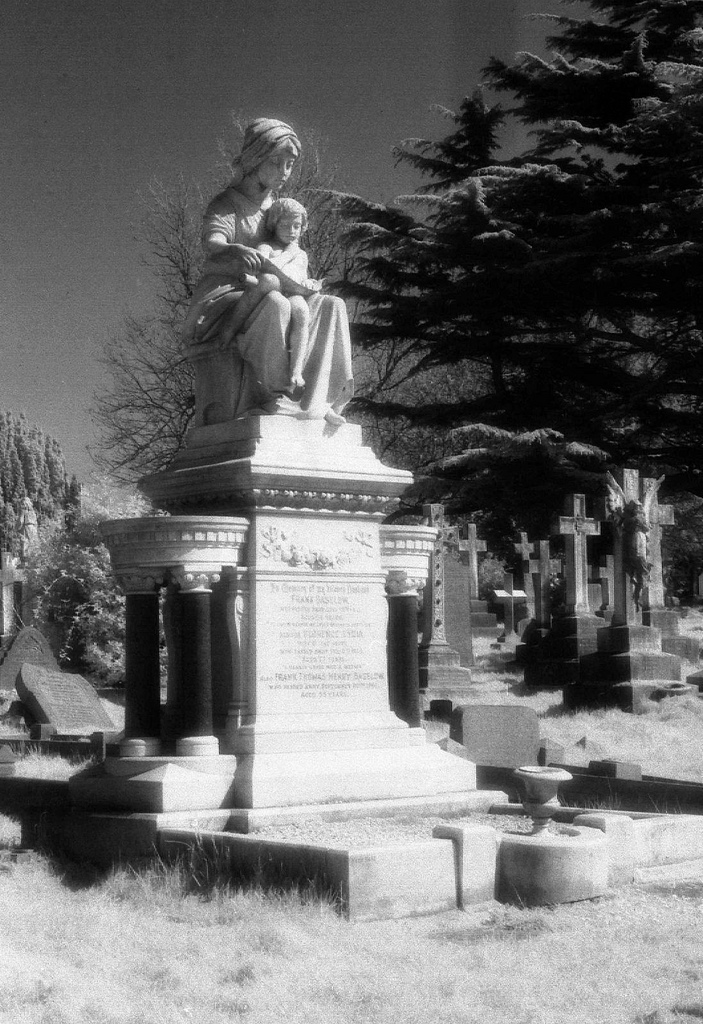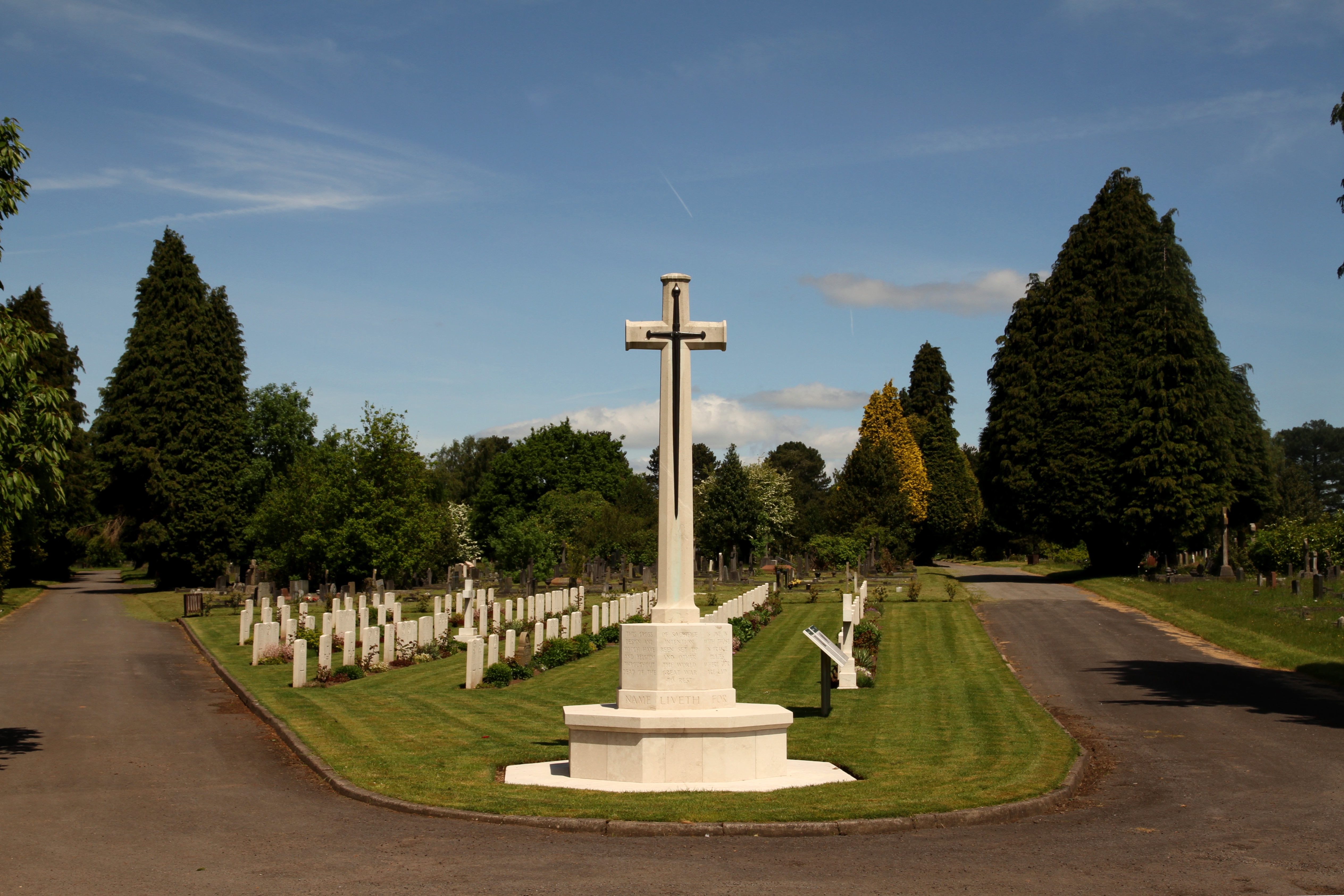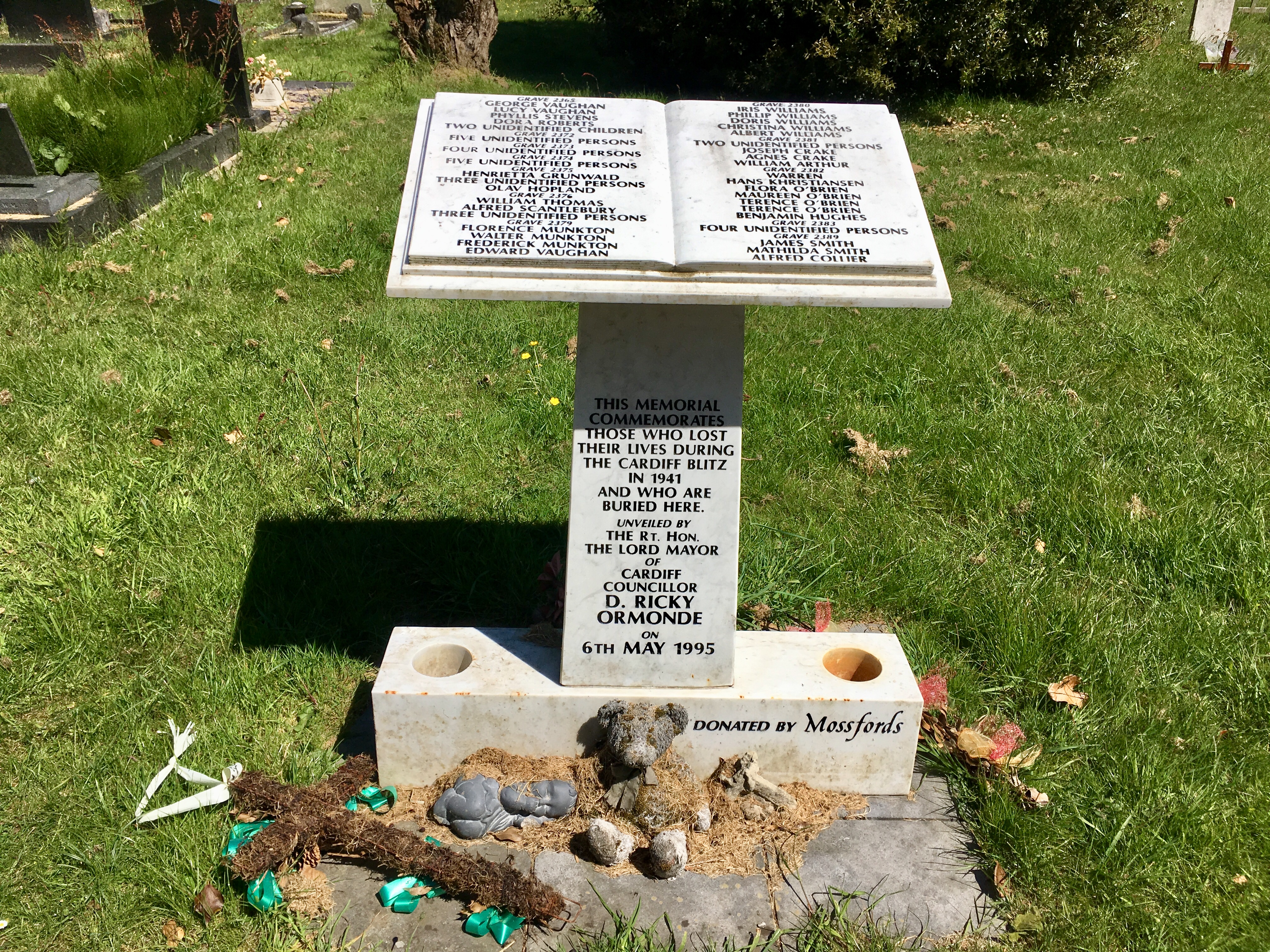Cathays Cemetery on:
[Wikipedia]
[Google]
[Amazon]
The Cathays Cemetery is one of the main cemeteries of
 The cemetery was opened in 1859 and originally had two chapels: one
The cemetery was opened in 1859 and originally had two chapels: one

 The cemetery has a
The cemetery has a
The Friends of Cathays Cemetery
* * * — photographs * — photographs {{coord, 51, 30, 06, N, 3, 10, 51, W, type:landmark_region:GB, display=title 1859 establishments in Wales Cathays Cemeteries in Cardiff Commonwealth War Graves Commission cemeteries in Wales
Cardiff
Cardiff (; cy, Caerdydd ) is the capital and largest city of Wales. It forms a principal area, officially known as the City and County of Cardiff ( cy, Dinas a Sir Caerdydd, links=no), and the city is the eleventh-largest in the United Kingd ...
, Wales. It is in the Cathays
Cathays ( ; Welsh: officially ''Cathays'' but also , 'the constant meadow') is a district and community in the centre of Cardiff, capital of Wales. It is an old suburb of Cardiff established in 1875. It is very densely populated and contains ma ...
district of the city, about north of Cardiff city centre
Cardiff city centre ( cy, Canol Dinas Caerdydd) is the city centre and central business district of Cardiff, Wales. The area is tightly bound by the River Taff to the west, the Civic Centre to the north and railway lines and two railway sta ...
. At 110 acres it is the third largest cemetery
A cemetery, burial ground, gravesite or graveyard is a place where the remains of dead people are buried or otherwise interred. The word ''cemetery'' (from Greek , "sleeping place") implies that the land is specifically designated as a buri ...
in the United Kingdom
The United Kingdom of Great Britain and Northern Ireland, commonly known as the United Kingdom (UK) or Britain, is a country in Europe, off the north-western coast of the continental mainland. It comprises England, Scotland, Wales and North ...
.
History
 The cemetery was opened in 1859 and originally had two chapels: one
The cemetery was opened in 1859 and originally had two chapels: one Anglican
Anglicanism is a Western Christian tradition that has developed from the practices, liturgy, and identity of the Church of England following the English Reformation, in the context of the Protestant Reformation in Europe. It is one of th ...
and the other non-conformist, and each including its own porte-cochère
A porte-cochère (; , late 17th century, literally 'coach gateway'; plural: porte-cochères, portes-cochères) is a doorway to a building or courtyard, "often very grand," through which vehicles can enter from the street or a covered porch-like ...
. The cemetery has a Roman Catholic
Roman or Romans most often refers to:
*Rome, the capital city of Italy
*Ancient Rome, Roman civilization from 8th century BC to 5th century AD
*Roman people, the people of ancient Rome
*'' Epistle to the Romans'', shortened to ''Romans'', a lette ...
section, where a Roman Catholic chapel was built later.
In the Second World War
World War II or the Second World War, often abbreviated as WWII or WW2, was a world war that lasted from 1939 to 1945. It involved the vast majority of the world's countries—including all of the great powers—forming two opposin ...
, air raids damaged Cathays Cemetery with a number of bombs and an aerial mine.
In the 20th century all three chapels were neglected and in the 1980s the Roman Catholic one was demolished. Since 2008 the Anglican and non-conformist chapels have been undergoing restoration. The chapels, as well as the cemetery gateway and forecourt walls, are Grade II listed buildings
In the United Kingdom, a listed building or listed structure is one that has been placed on one of the four statutory lists maintained by Historic England in England, Historic Environment Scotland in Scotland, in Wales, and the Northern Irel ...
.
During the early/mid 1970s the cemetery was split into two sections to allow the building of the A48 Eastern Avenue which was a continuation of the A48(M).
One of the most imposing memorials is that of Frank Baselow, thought to be a result of Baselow's Europe
Europe is a large peninsula conventionally considered a continent in its own right because of its great physical size and the weight of its history and traditions. Europe is also considered a Continent#Subcontinents, subcontinent of Eurasia ...
an heritage (his actual name was Franz) and the taste on the Continent for grand memorials.
War graves

 The cemetery has a
The cemetery has a Commonwealth War Graves
The Commonwealth War Graves Commission (CWGC) is an intergovernmental organisation of six independent member states whose principal function is to mark, record and maintain the graves and places of commemoration of Commonwealth of Nations mi ...
(CWGC) section, marked by a Cross of Sacrifice
The Cross of Sacrifice is a Commonwealth war memorial designed in 1918 by Sir Reginald Blomfield for the Imperial War Graves Commission (now the Commonwealth War Graves Commission). It is present in Commonwealth war cemeteries containing 40 or ...
made to the standard design devised by Reginald Blomfield
Sir Reginald Theodore Blomfield (20 December 1856 – 27 December 1942) was a prolific British architect, garden designer and author of the Victorian and Edwardian period.
Early life and career
Blomfield was born at Bow rectory in Devon, w ...
. The section was established in the First World War
World War I (28 July 1914 11 November 1918), often abbreviated as WWI, was one of the deadliest global conflicts in history. Belligerents included much of Europe, the Russian Empire, the United States, and the Ottoman Empire, with fightin ...
, when Cardiff's nearby main hospitals treated numerous servicemen who had been wounded in action, or who contracted influenza
Influenza, commonly known as "the flu", is an infectious disease caused by influenza viruses. Symptoms range from mild to severe and often include fever, runny nose, sore throat, muscle pain, headache, coughing, and fatigue. These symptoms ...
in the 1918–19 influenza pandemic.
The war graves section includes a number of graves of Australian and Canadian servicemen, one New Zealander who died while serving in the Royal Defence Corps The Royal Defence Corps was a corps of the British Army formed in 1916 and disbanded in 1936.
As part of the reorganisation of home defence forces by Field Marshal Sir John French, Commander-in-Chief, Home Forces, the Royal Defence Corps was crea ...
, and one soldier of the Prince of Wales's Leinster Regiment
The Prince of Wales's Leinster Regiment (Royal Canadians) was an infantry regiment of the line in the British Army, formed in 1881 by the amalgamation of the 100th (Prince of Wales's Royal Canadian) Regiment of Foot and the 109th Regiment of Foot ...
. Also present is the grave of Jacques Vaillant de Guélis, a Special Operations Executive
The Special Operations Executive (SOE) was a secret British World War II organisation. It was officially formed on 22 July 1940 under Minister of Economic Warfare Hugh Dalton, from the amalgamation of three existing secret organisations. Its pu ...
agent.
The cemetery includes the graves of 21 French Navy
The French Navy (french: Marine nationale, lit=National Navy), informally , is the maritime arm of the French Armed Forces and one of the five military service branches of France. It is among the largest and most powerful naval forces in t ...
sailors from the First World War, mostly in the Roman Catholic section, and a similar number of Norwegian sailors from the Second.
Elsewhere in the cemetery are numerous Commonwealth War Graves from both the First and Second World Wars. The cemetery contains the graves of 685 service personnel which are registered and maintained by the CWGC.
Victims of the Cardiff Blitz
The Cardiff Blitz ( cy, Blitz Caerdydd); refers to the bombing of Cardiff, Wales during World War II. Between 1940 and the final raid on the city in March 1944 approximately 2,100 bombs fell, killing 355 people.
Cardiff Docks became a strate ...
who are buried in the cemetery are commemorated by a memorial erected in 1993.
Notable interments
* Robert Bird,Liberal Party
The Liberal Party is any of many political parties around the world. The meaning of ''liberal'' varies around the world, ranging from liberal conservatism on the right to social liberalism on the left.
__TOC__ Active liberal parties
This is a li ...
politician
*Sir James Cory, 1st Baronet
Sir James Herbert Cory, 1st Baronet (2 February 1857 – 2 February 1933) was a Welsh politician and ship-owner.
He was born at Padstow, the younger son of John Cory (founder of Cardiff-based firm John Cory, Sons & Co – not to be confused wit ...
, shipowner and Conservative Party
The Conservative Party is a name used by many political parties around the world. These political parties are generally right-wing though their exact ideologies can range from center-right to far-right.
Political parties called The Conservative P ...
politician
*Jim Driscoll
James Driscoll (15 December 1880 – 30 January 1925), commonly known as Peerless Jim, was a Welsh boxer who learned his trade in the boxing ring and used it to fight his way out of poverty. Driscoll was British featherweight champion an ...
, boxer
*John Emlyn-Jones
John Emlyn Emlyn-Jones (22 January 1889 – 3 March 1952) was a Welsh Liberal Party politician and shipowner.
Education and shipping
Emlyn-Jones had a private education in Cardiff, France, Spain and Italy''Who was Who'', OUP 2007 before making ...
, shipowner and Liberal politician
* John Humphrey England, founder of Edward England Potatoes.
*John Cuthbert Hedley
John Cuthbert Hedley (15 April 1837 – 11 November 1915) was a British Benedictine and writer who held high offices in the Roman Catholic Church.
Born in Morpeth, Northumberland, he was the son of Dr. Edward Astley Hedley and Mary Ann ( Davison ...
, Roman Catholic bishop
* Archibald Hood, colliery owner
*Thomas Rowland Hughes
Thomas Rowland Hughes (often referred to as T. Rowland Hughes) (17 April 1903 – 24 October 1949), was a Welsh broadcaster, novelist, dramatist and poet. He was the son of a quarryman from Llanberis, Caernarvonshire ( Gwynedd today), in north Wa ...
, writer
*David (Dai) Lewis, professional boxer murdered by Driscoll and Rowlands in 1927 (contested)
*Hilary Marquand
Hilary Adair Marquand, (24 December 1901 – 6 November 1972) was a British economist and Labour Party politician.
Life and career
He was born in Cardiff, the son of Alfred Marquand of Saint Peter Port, Guernsey, a clerk in a coal exporting ...
, Labour Party politician
*Sir William Henry Seager
Sir William Henry Seager (1862 – 10 March 1941) was a Welsh shipping magnate and Liberal Party politician who spent four years as a Member of Parliament (MP).
Life
The Seager family were originally from Ilfracombe, Devon, but moved to ...
, shipowner and Liberal politician
* Frances Batty Shand, founder of Cardiff Institute for the Blind
*Sir William Reardon Smith
Sir William Reardon Smith, 1st Baronet (7 August 1856 – 23 December 1935) was an English shipowner and philanthropist.
Early life
Reardon Smith was born in Appledore, Devon, the youngest son of Thomas Reardon Smith, a sailing ship captain, and ...
, 1st Baronet, shipowner
*William Tatem, 1st Baron Glanely
William James Tatem, 1st Baron Glanely (6 March 1868 – 28 June 1942), known as Sir William Tatem, Bt, between 1916 and 1918, was a Cardiff ship-owner and thoroughbred racehorse owner and breeder.
Career
Tatem was born in Appledore, North D ...
, shipowner
*Sir Tudor Thomas, ophthalmic surgeon
* Alfred Thomas, 1st Baron Pontypridd, Liberal politician
*Maurice Turnbull
Maurice Joseph Lawson Turnbull (16 March 1906 – 5 August 1944) was a Welsh cricketer who played in nine Test matches for the England cricket team between 1930 and 1936.
A talented all round sportsman, Turnbull excelled in several sports. In ...
, Glamorgan and England cricketer
*Ernest Willows
Ernest Thompson Willows (1886–1926) was a pioneer Welsh aviator and airship builder. He became the first person in the United Kingdom to hold a pilots certificate for an airship when the Royal Aero Club awarded him ''Airship Pilots Certificate ...
, aviation pioneer and airship builder
*Several Senghenydd Colliery Disaster
The Senghenydd colliery disaster, also known as the Senghenydd explosion ( cy, Tanchwa Senghennydd), occurred at the Universal Colliery in Senghenydd, near Caerphilly, Glamorgan, Wales, on 14 October 1913. The explosion, which killed 439 coal ...
victims
Notes
Sources and further reading
* *External links
The Friends of Cathays Cemetery
* * * — photographs * — photographs {{coord, 51, 30, 06, N, 3, 10, 51, W, type:landmark_region:GB, display=title 1859 establishments in Wales Cathays Cemeteries in Cardiff Commonwealth War Graves Commission cemeteries in Wales